
With the ever-growing number of touchpoints throughout the buyer journey, customer information becomes a black box. Customer satisfaction surveys are the only way to keep tabs on your brand’s sentiment.
A customer satisfaction survey is a valuable tool that can help brands build strong relationships and create a loyal customer base using the power of feedback.
- But why are customer satisfaction surveys important?
- What should they include?
- What are the different types of surveys, and when should they be used?
We’ll answer these questions and much more.
Here’s everything you need to know about customer satisfaction surveys to take your business to the next level.
Why customer satisfaction surveys are important
Like trying to fill in a leaking bucket, bringing in new customers without keeping the old ones is not sustainable. To retain customers, you must ensure their satisfaction with your products or services.
The only way to remain relevant is by requesting feedback from people who use your products daily. Here are the main benefits of conducting surveys:
- Easy way to ask for feedback: One of the prerequisites of a long-lasting customer relationship is the ability to ask and listen. Surveys are a quick and easy way for customers to leave specific feedback. Plus, they are more interactive than asking for feedback via email/chat.
- Identifying technical issues: There’s always a chance for something to slip through the cracks. A glitch on the website, a complicated checkout process, or issues with getting customer support. Satisfaction surveys can give you first-hand feedback on things you can improve.
- Discovering new opportunities: Besides pinpointing improvement areas, customer satisfaction surveys can help you gather ideas for new products, services, features, or platform enhancements. If you notice that some customers’ expectations and wants constantly repeat throughout the answers, consider introducing them to your entire customer base.
- Gaining a competitive edge: Putting customers first will always get you ahead. Keeping up with customers’ changing needs is impossible without their feedback.
- Monitoring progress over time: Your business must evolve. The cost of the status quo gets higher as time goes by. To succeed in the long run, you must make incremental improvements based all the time.
How to measure customer satisfaction
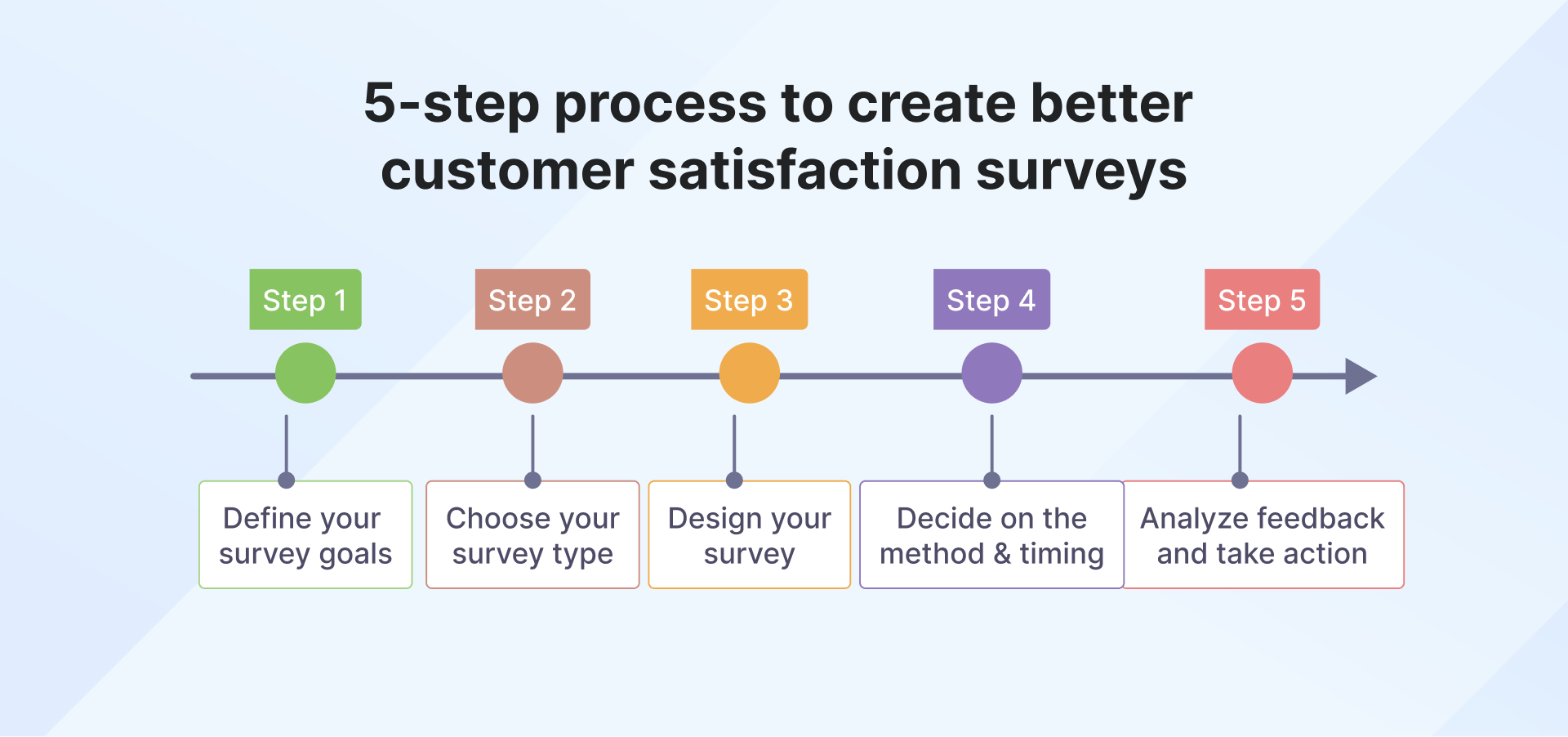
While there are no strict rules for customer satisfaction surveys, there are five steps you should follow to ensure you get valid results that can help you make informed decisions.
Step 1: Define your goals
You need to know where you’re going to get there. Setting goals before launching a customer satisfaction survey is the only way to collect results that will lead to action. Knowing your end goal will empower you to ask the right questions, use the most appropriate channel, and define the right target audience.
Step 2: Choose a type of customer satisfaction survey
After defining your goals, you will have a clear picture of the best survey for that occasion. Whether you want to check in with customers after a purchase or measure your customers’ loyalty, you have many customer satisfaction surveys at your disposal.
Your job is to understand how to use them to achieve your goals and get your desired answers.
Step 3: Design your survey
How you design your survey can make or break the whole process and affect the results you collect. At this point, you should know your goals and the type of customer satisfaction survey that will enable you to gather the right feedback.
The next step is to design your survey. Here are the things you need to consider during the design stage:
- Define the adequate sample size;
- Decide on the required response rate;
- Design the questions you will include in the survey.
Step 4: Decide on the method and timing
Another crucial step in conducting a successful customer satisfaction survey is your method and timing. Consider the best survey format for your audience—is it an online poll, email survey, paper questionnaire, or personal interview?
Should you consider multiple formats?
Timing is also essential. If you want to measure post-purchase satisfaction, you can’t wait too long after the purchase. The opposite is true if you want to measure customer loyalty.
Step 5: Analyze customer feedback and take action
Conducting customer satisfaction surveys without taking action is a waste of time and money. The feedback you gather from your customers should give you a clear direction about things you need to prioritize and the next steps you should undertake to improve the customer experience.
Use quantitative data to reveal trends and preferences and qualitative data to understand their reasoning further.
What should a customer satisfaction survey include
The elements of a customer satisfaction survey depend on the type of survey you want to conduct. However, some key elements are common in every customer satisfaction survey:
- Introduction that sets expectations – Use the introduction to give respondents context and set the right expectations. After you explain the purpose of the survey, give instructions and specify how long it will take them to complete it.
- Clear call to action – Your goal is to get more responses. Including multiple links and calls to action will distract customers from the main one—to complete the survey. Use a bigger, bolder font or a call to action button to get customers’ attention and point them in the right direction.
- Questions relevant to your main goal – Many companies ask the wrong survey questions, which leads to survey bias. Avoid burdening customers with too many questions. Make sure your questions are short, clear, and to the point.
Customer satisfaction survey examples
To decide what type of customer satisfaction survey you need for a specific purpose, you must understand the different types you have at your disposal. In this section, we’ll cover the what, why, and how of the most popular customer satisfaction surveys and share examples that will inspire you to create.
1. Customer satisfaction score (CSAT)
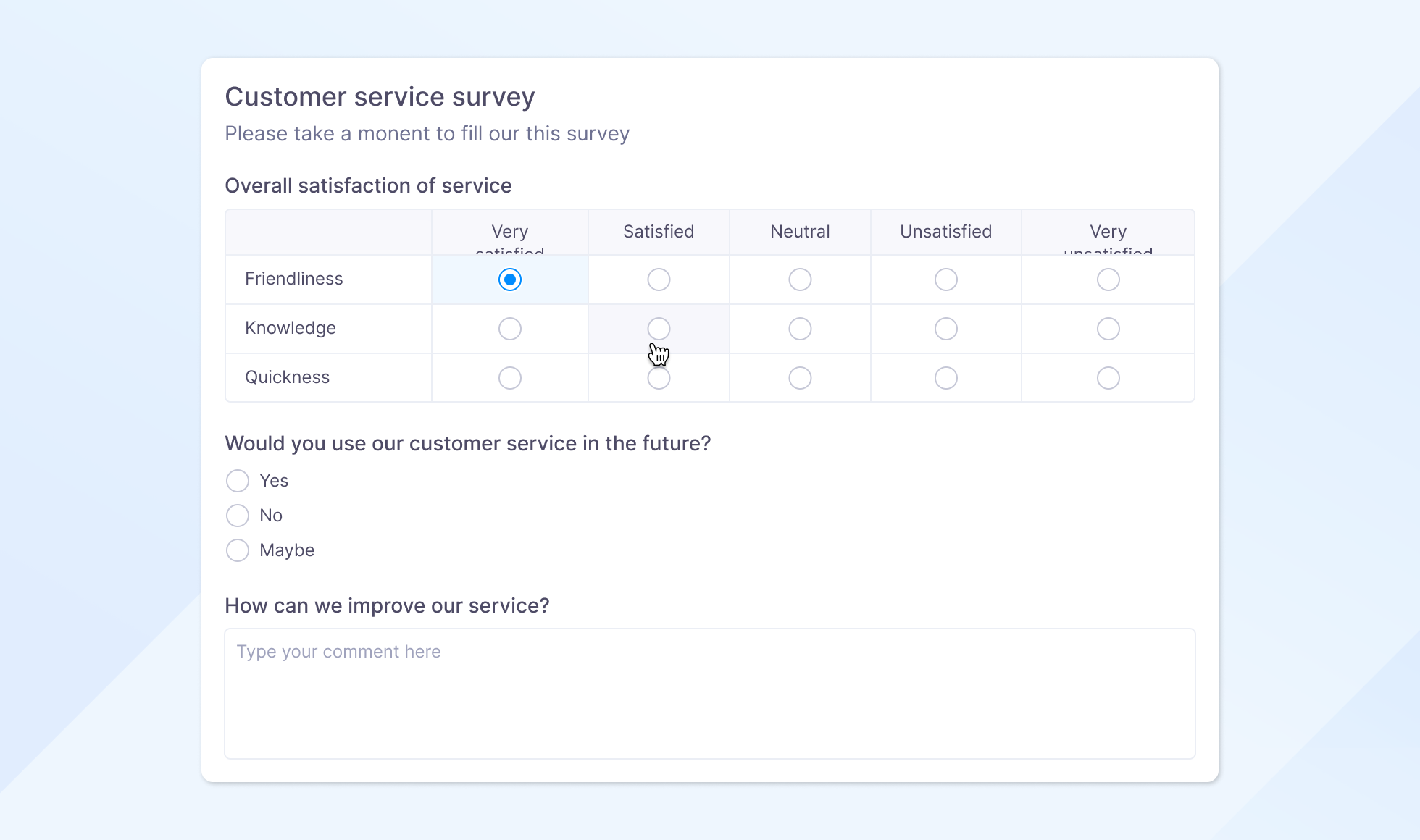
Customer satisfaction score, or CSAT, is a customer experience metric that indicates customer satisfaction with a company’s products or services. You can easily recognize this customer satisfaction survey by asking, “How satisfied were you with [company]?“
The CSAT survey is composed of several questions allowing customers to express their level of satisfaction by selecting one of the multiple choices. In most cases, customers can choose between the following responses:
- Very satisfied
- Satisfied
- Neutral
- Unsatisfied
- Very unsatisfied
CSAT is one of the fundamental customer satisfaction surveys businesses should conduct periodically to ensure customers are satisfied with the company and its products and services.
2. Net promoter score survey (NPS®)
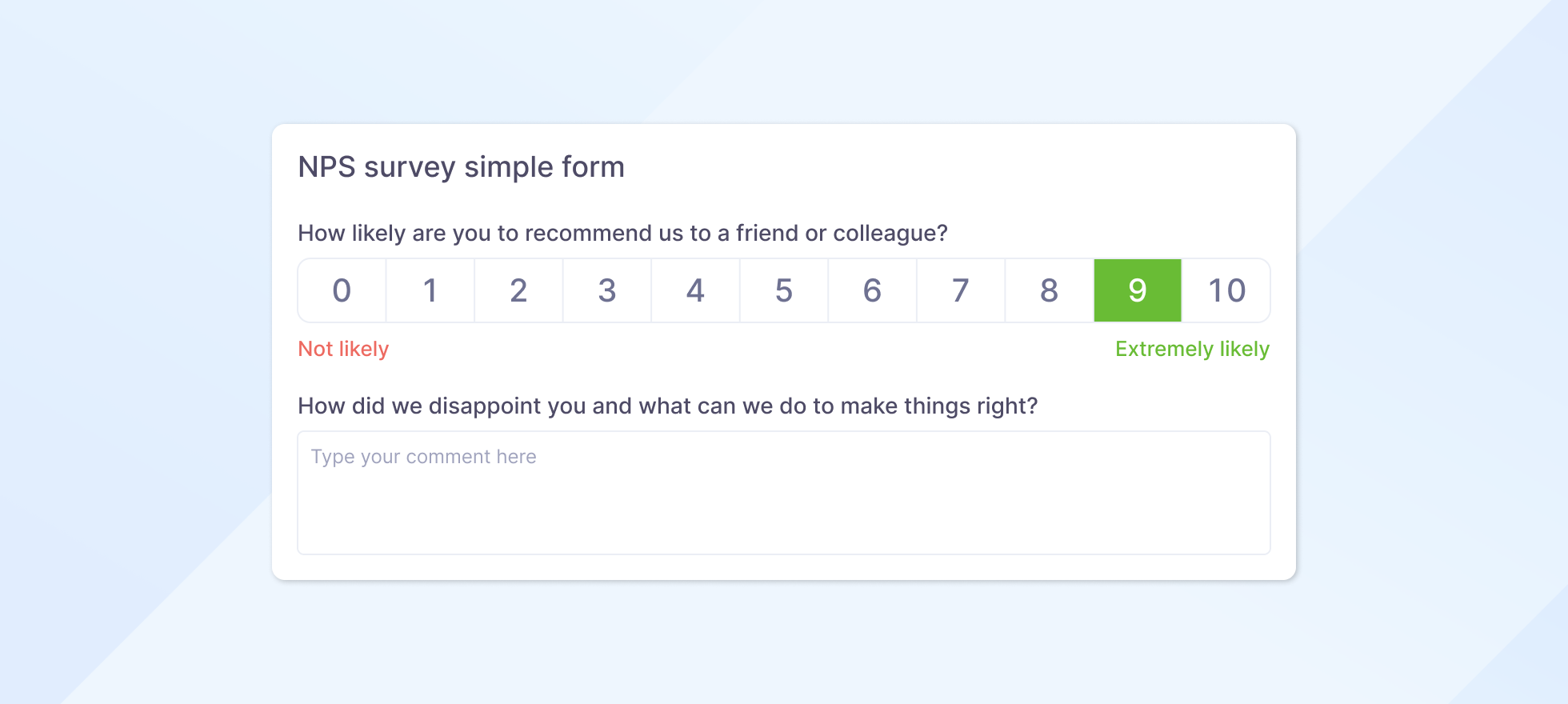
Net Promoter Score or NPS is a customer success metric that measures the likelihood of a customer recommending a product or service to others. NPS indicates customers’ propensity to advocate for the brand using one survey question: “How likely are you to recommend [Company/Product/Service] to a friend or colleague?”
Respondents give a rating between 0 (not likely at all) and 10 (extremely likely). Depending on their response, customers fall into one of 3 categories:
- 🙂 Promoters – Loyal and happy customers who respond with a score of 9 or 10
- 😐 Passives – Satisfied but not happy customers who respond with a score of 7 or 8.
- 🙁 Detractors – Unhappy customers who are unlikely to buy from you again but can also negatively influence others and respond with a score of 0 to 6.
To calculate the final NPS score, you should subtract the percentage of Detractors from the percentage of Promoters. NPS provides a score ranging from −100 to 100, and a higher score means more customers are likely to recommend your products or services. NPS can also indicate customer loyalty and be used to predict business growth.
CSAT and NPS have different advantages and disadvantages and are very effective when used together. The bottom line is that CSAT measures how satisfied customers are with their experience with your product, while NPS measures how likely they are to recommend your products or services to others.
3. Customer effort score survey (CES)
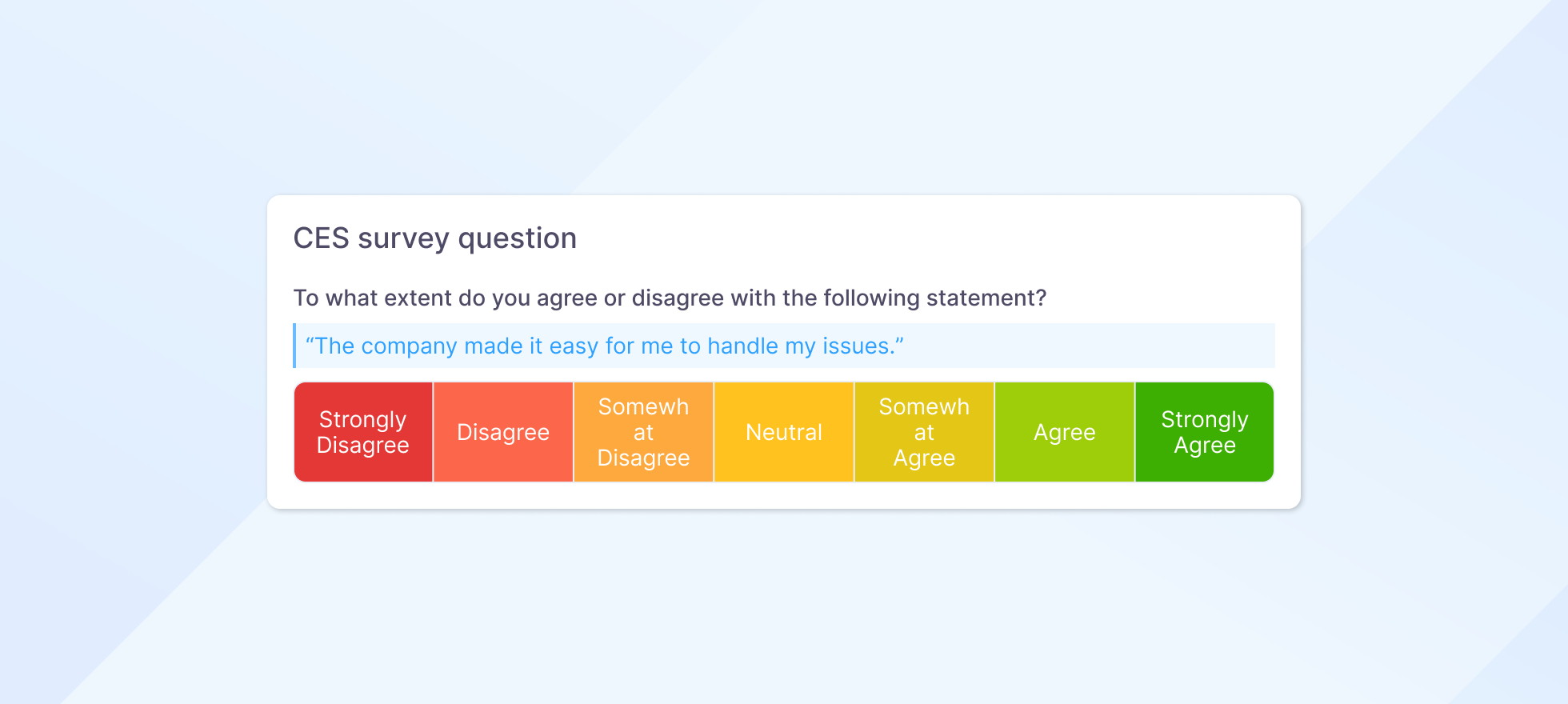
Customer Effort Score, also known as CES, is a service metric that measures a product or service’s ease of use. Customers expect seamless experiences, and if your product or services require extra effort, they might lose motivation, leading to frustration.
While there’s no universal benchmark, customers are usually asked to assess an experience or interaction with the company on a scale of 1-5 or 1-7. By responding to a statement like “[Company] made it easy for me to handle my issue,” customers can help businesses understand the effort needed to use a product, find information, or resolve an issue.
A high CES score means your business offers a seamless experience for customers. On the contrary, a low CES is a red flag indicating some issues in the processes.
CES’s one limitation is that it reflects a single interaction rather than the overall experience. You must combine this customer satisfaction survey with others, such as CSAT and NPS, to get the big picture.
4. Five-star satisfaction survey
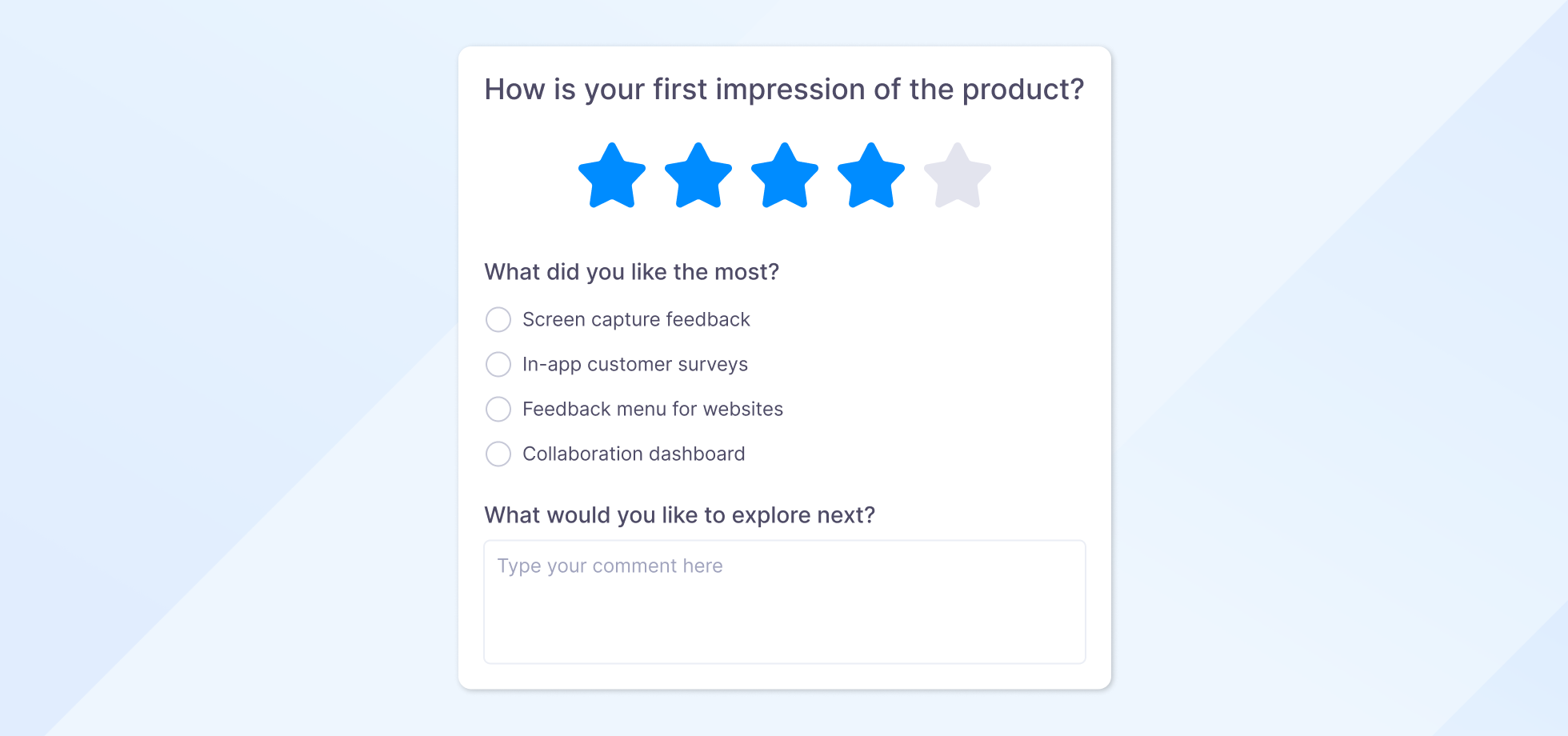
A 5-star survey is a customer feedback questionnaire that measures satisfaction with a product or service using a 5-point rating scale. The 5-star survey is a variety of the CSAT survey, a popular method of collecting customer feedback.
The concept of a 5-star rating is widely recognized and adopted, which makes this survey one of the easiest and quickest ways to gather responses. The logic behind it is straightforward—customers are asked to rate a product, service, interaction, or experience on a scale of 1 to 5 stars. Five stars represent excellent performance, while one indicates a poor customer experience.
One of the limitations of this customer satisfaction survey is that asking one question needs to give you more details to understand the reasoning behind the answer. As a result, the 5-star survey is usually followed up with an open-ended question, giving customers a chance to expand on their answers.
On the plus side, the 5-star survey is interactive and an excellent way to gather social proof that you later use in your marketing materials.
5. Smiley face surveys
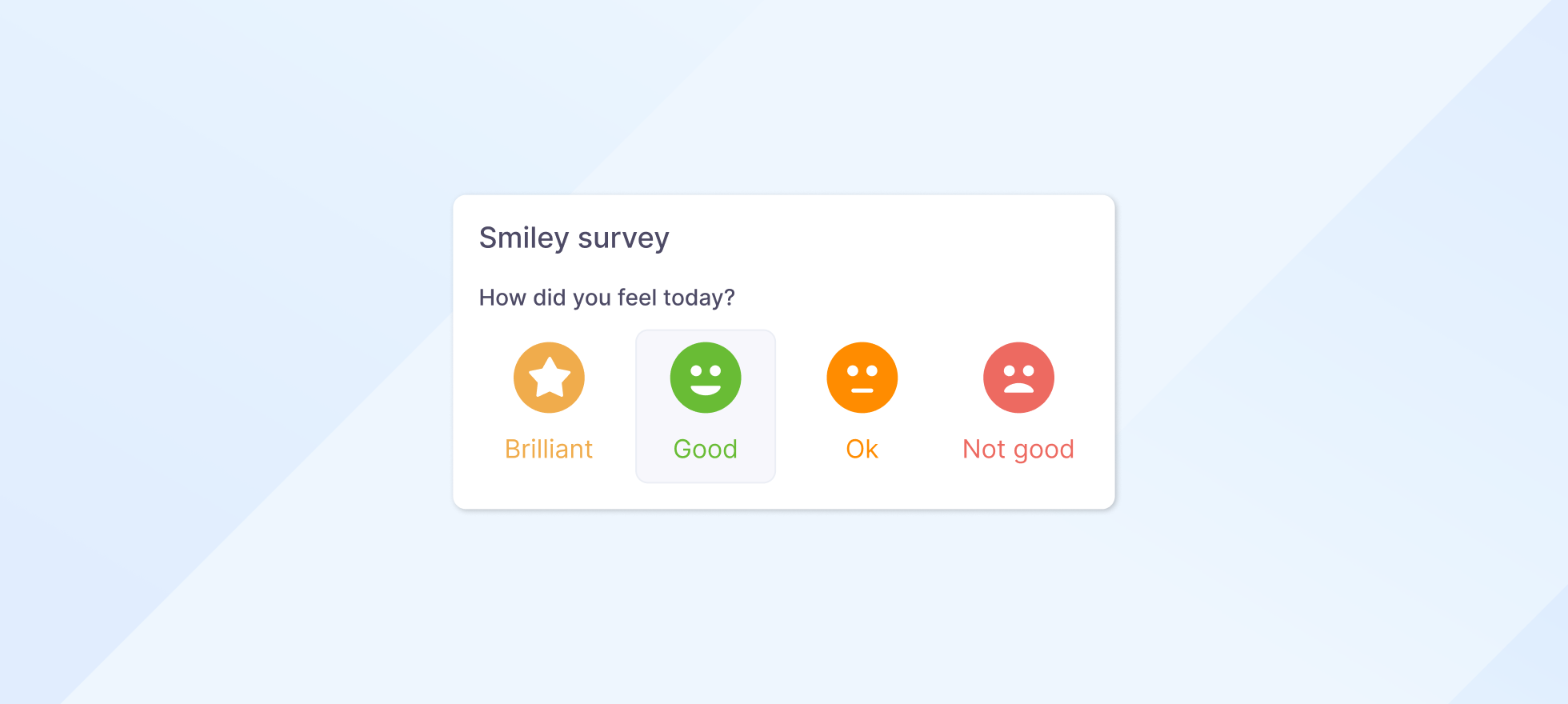
A smiley face survey is a customer feedback collection method that uses emojis with different expressions to reflect a customer’s experience with the business. The emoji expressions are a great visual tool that allows customers to express their feelings—ranging from a frown, a neutral expression, to a smile.
Emojis have become a standard element in our daily written communication and are widely recognizable. Using smiley face surveys makes it easy for customers hesitant to share negative feedback in words.
The simplicity of the smiley face survey allows businesses to use it across different forms and touchpoints, such as popups and email signatures.
6. Post-purchase satisfaction survey

A post-purchase survey includes questions you ask your customers soon after they complete a purchase from your business. You can customize this type of survey depending on the goals you want to achieve.
Based on the answers you receive from your customers, you can enhance the customer experience and improve the weak points in the journey.
Post-purchase satisfaction surveys are common for e-commerce businesses, and two of the most common formats used for this type of survey are email surveys and thank-you page surveys.
You can use a post-purchase survey to identify issues in the customer experience, understand which channels perform the best in customer acquisition, and get insights into customer preferences to refine your marketing strategy further.
7. Product-market fit score (PMF)

The product-market fit survey (the Sean Ellis test) measures product-market fit by asking customers, “How would you feel if you could no longer use our product?” There are three potential answers to the question:
- Very disappointed
- Somewhat disappointed
- Not disappointed
If 40% or more of the replies to the product-market fit survey are “very disappointed,” you have achieved a product-market fit.
Reaching your product-market fit is vital for every business, making the PMF score vital. A good score means you have the right product in the right market.
8. Usability survey
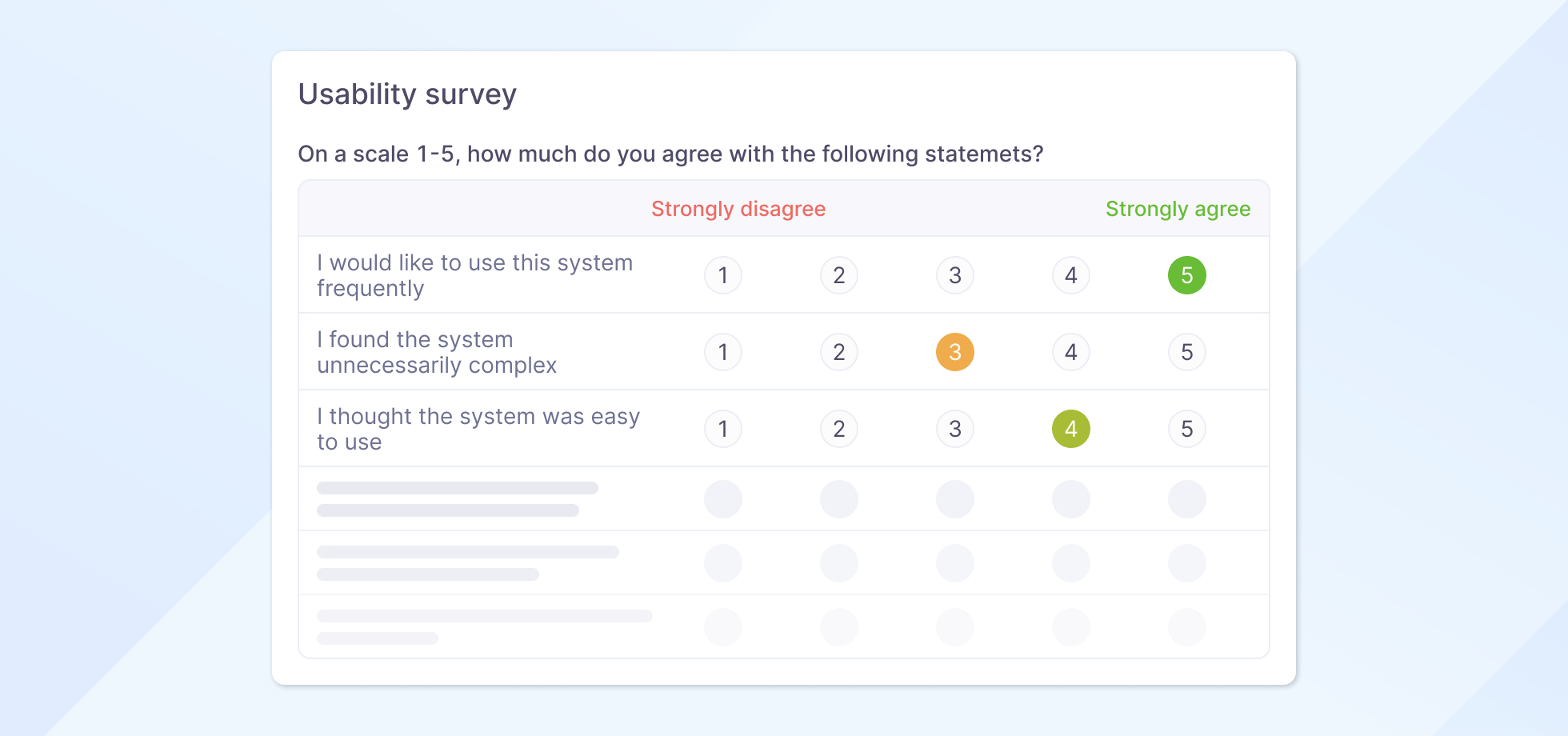
Usability or user experience (UX) surveys help businesses understand the what, why, and how of a product and its users. This type of survey includes questions determining how easy (or hard) it is to use a website, an application, or software.
With the help of UX surveys, companies can get first-hand feedback, learn whether the product works as expected, and close their customer feedback loop. Businesses can use rating scales or multiple-choice responses to collect answers. An example of a usability survey question is “How would you rate using [product]?”
One of the challenges of usability surveys is finding participants. It would help if you used demographic and background screening questions to get participants representing your target audience. This way, you will choose the right participants and gather more relevant information.
Collect customer feedback with SMS surveys
Automate survey collection with intuitive SMS surveys
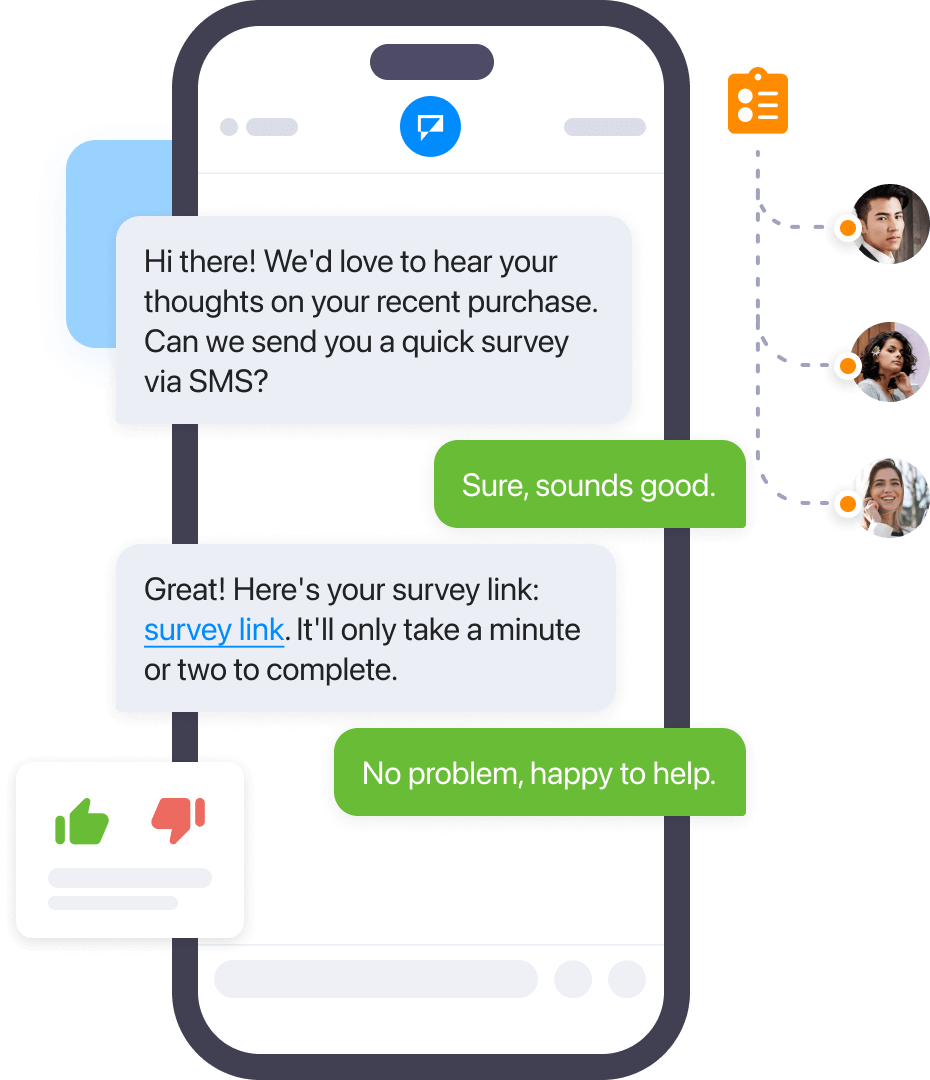
Customer satisfaction survey best practices
The process of gathering customer feedback can feel daunting. To help you maximize your efforts and get actionable insights, we’ve prepared a 10-point checklist with customer satisfaction survey best practices.
| BEST PRACTICE | WHY IT MATTERS |
| ✔️ Keep the survey short | Customers don’t have time to elaborate on your questions. Keep the survey short, clear, and easy to respond to. |
| ✔️ Ask the right questions | Always test before sending a customer satisfaction survey. This will help you avoid mistakes before customers receive the survey. |
| ✔️ Nail the timing | Reaching out to customers promptly will help you gather more answers. For example, if you want to collect feedback about a purchase experience, you can’t wait too long to reach out to customers. |
| ✔️ Use consistent rating scales | If you have multiple questions, use consistent rating scales to avoid confusion. |
| ✔️ Avoid jargon | Clear is always better than clever. Your goal is to get answers, which means the questions should be clear and straightforward. |
| ✔️ Customize your survey | Use your company’s branding to make the survey recognizable. |
| ✔️ Test before you send | Respond to customers’ feedback, whether it is positive or negative, to show customers you value their time and their opinions. |
| ✔️ Send reminders | Customers are busy, so you can’t expect them to respond to your survey immediately. However, don’t be pushy. One reminder is enough. |
| ✔️ Follow up | Respond to customers’ feedback, whether it is positive or negative, to show customers you value their time and their opinion. |
| ✔️ Act on results | Satisfaction surveys aim to understand customers’ wants and needs and take action. Gathering feedback without acting won’t have any positive impact on your business. |
How to analyze customer satisfaction survey data
After you collect feedback, you need to analyze data to be able to draw conclusions. Here are some of the things you need to keep in mind when analyzing customer satisfaction survey data:
- Remove incomplete data;
- Make sure your findings are statistically significant before you conclude;
- Look for trends and patterns;
- Compare data against previous benchmarks;
- Use qualitative data to support quantitative data findings.
Do customer satisfaction surveys work?
Keeping a pulse on customer satisfaction is essential for business growth. If you’re looking to increase customer lifetime value, boost loyalty, and decrease churn, conduct regular customer satisfaction surveys.
Use a single platform to unify every step of the customer journey, engage customers, handle customer support requests, and measure customer satisfaction. This will give you a competitive edge and fuel your business.
Frequently Asked Questions (FAQs)
The American Customer Satisfaction Index (ACSI) model measures satisfaction by combining data on customer expectations, perceived quality, and perceived value.
This approach provides a more complete view of what influences satisfaction.
You can set up virtual assistants to automatically deliver surveys once a customer’s issue is resolved or a purchase is completed.
The questions can be personalized based on the customer’s recent experience, making feedback more relevant.
Instead of sending out surveys, you can use internal key performance indicators to measure customer satisfaction. These can include contract renewal rates, which reveal the percentage of customers continuing their agreements.
Also, customer lifetime value offers insight into the revenue potential tied to satisfaction.
Tracking first-contact resolution rates in support interactions reflects the quality of service that impacts ongoing customer relationships.
Related articles
Mastering customer segments: Strategies to boost your ROI
One of the most effective ways to differentiate your...
What is vishing? Unmasking voice phishing scams and techniques
Vishing, an insidious blend of voice communication a...
A2P vs P2P messaging: Differences, benefits & use cases
With the prevalence of smartphones and mobile apps, ...
A step-by-step guide to successful omnichannel communication
Discover the power of omnichannel communication for ...
Crafting a winning sales pitch: 22 Proven examples to inspire you
Discover our selection of sales pitch examples that ...




